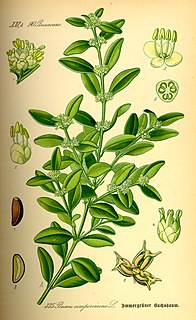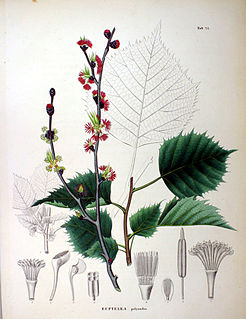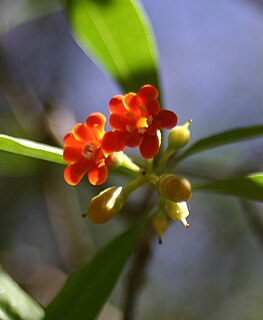
The Saxifragales are an order of flowering plants. Their closest relatives are a large eudicot group known as the rosids, following the definition of the Angiosperm Phylogeny Group classification system. Saxifragales is one of the groups that compose the core eudicots, which consists of the Dilleniaceae, superasterids and superrosids, the latter consisting of the Saxifragales and rosids.

Ranunculales is an order of flowering plants. Of necessity it contains the family Ranunculaceae, the buttercup family, because the name of the order is based on the name of a genus in that family. Ranunculales belongs to a paraphyletic group known as the basal eudicots. It is the most basal clade in this group; in other words, it is sister to the remaining eudicots. Widely known members include poppies, barberries, and buttercups.

Proteales is the botanical name of an order of flowering plants consisting of two families. The Proteales have been recognized by almost all taxonomists.

The Francoaceae are a small family of plants in the order Geraniales, including the genera Francoa, commonly known as bridal wreaths, and Tetilla. The Francoaceae are recognized as a family under various classification schemes but under the APG III system the Francoaceae are included within the Melianthaceae. In the APG IV system the Francoaceae are again recognized as a family, with Melianthaceae included in the circumscription of Francoaceae.

The Buxales are a small order of eudicot flowering plants, recognized by the APG IV system of 2016. The order includes the family Buxaceae; the families Didymelaceae and Haptanthaceae may also be recognized or may be included in the Buxaceae. Many members of the order are evergreen shrubs or trees, although some are herbaceous perennials. They have separate "male" (staminate) and "female" (carpellate) flowers, mostly on the same plant. Some species are of economic importance either for the wood they produce or as ornamental plants.

Gunneraceae is a family of flowering plants, closely related to Myrothamnaceae, together forming the order Gunnerales. Such a family has been recognized by most taxonomists. Gunneraceae consists of the single genus Gunnera with 63 known species

The Restionaceae, also called restiads and restios, are a family of annual or perennial rush-like flowering plants native to the Southern Hemisphere; they vary from a few centimeters to 3 m in height. Following the APG IV (2016): the family now includes the former families Anarthriaceae, Centrolepidaceae and Lyginiaceae, and as such includes 51 genera with 572 known species. Based on evidence from fossil pollens, the Restionaceae likely originated more than 65 million years ago during the Late Cretaceous period, when the southern continents were still part of Gondwana.

Petrosaviaceae is a family of flowering plants belonging to a monotypic order, Petrosaviales. Petrosaviales are monocots, and are grouped within the lilioid monocots. Petrosaviales are a very small order of photosynthetic (Japonolirion) and rare leafless achlorophyllous, mycoheterotrophic plants (Petrosavia) found in dark montane rainforests in Japan, China, Southeast Asia and Borneo. They are characterised by having bracteate racemes, pedicellate flowers, six persistent tepals, septal nectaries, three almost distinct carpels, simultaneous microsporogenesis, monosulcate pollen, and follicular fruit.

The Angiosperm Phylogeny Group, or APG, is an informal international group of systematic botanists who collaborate to establish a consensus on the taxonomy of flowering plants (angiosperms) that reflects new knowledge about plant relationships discovered through phylogenetic studies.

The Xyridaceae are a family of flowering plants. The botanical name has been recognized by many taxonomists and is known as the yellow-eyed grass family.

Asphodelaceae is a family of flowering plants in the order Asparagales. Such a family has been recognized by most taxonomists, but the circumscription has varied widely. In its current circumscription in the APG IV system, it includes about 40 genera and 900 known species. The type genus is Asphodelus.

Trimeniaceae is a family of flowering plants recognized by most taxonomists, at least for the past several decades. It is a small family of one genus, Trimenia, with eight known species of woody plants, bearing essential oils. The family is subtropical to tropical and found in Southeast Asia, eastern Australia and on several Pacific Islands.

Euptelea is a genus of two species of flowering plants in the monogeneric family Eupteleaceae. The genus is found from Assam east through China to Japan, and consists of shrubs or small trees:
The APG system of plant classification is the first version of a modern, mostly molecular-based, system of plant taxonomy. Published in 1998 by the Angiosperm Phylogeny Group, it was replaced by the improved APG II in 2003, APG III system in 2009 and APG IV system in 2016.
The APG II system of plant classification is the second, now obsolete, version of a modern, mostly molecular-based, system of plant taxonomy that was published in April 2003 by the Angiosperm Phylogeny Group. It was a revision of the first APG system, published in 1998, and was superseded in 2009 by a further revision, the APG III system.

In plant taxonomy, commelinids is a name used by the APG IV system for a clade within the monocots, which in its turn is a clade within the angiosperms. The commelinids are the only clade that the APG has informally named within the monocots. The remaining monocots are a paraphyletic unit. Also known as the commelinid monocots it forms one of three groupings within the monocots, and the final branch, the other two groups being the alismatid monocots and the lilioid monocots.

Theophrastaceae was a small family of flowering plants, no longer recognized in recent classifications. As previously circumscribed, the family consisted of seven genera and 95 species of trees or shrubs, native to tropical regions of the Americas.

Caryophyllales is an order of flowering plants that includes the cacti, carnations, amaranths, ice plants, beets, and many carnivorous plants. Many members are succulent, having fleshy stems or leaves.

Iteaceae is a flowering plant family of trees and shrubs native to the eastern USA, southeastern Africa, and south and Southeastern Asia. Some older taxonomic systems place the genera in this family in the Grossulariaceae. The APG III system of 2009 includes the former Pterostemonaceae in Iteaceae. It consequently now has two genera with a total of 18 known species.
The APG III system of flowering plant classification is the third version of a modern, mostly molecular-based, system of plant taxonomy being developed by the Angiosperm Phylogeny Group (APG). Published in 2009, it was superseded in 2016 by a further revision, the APG IV system.



















